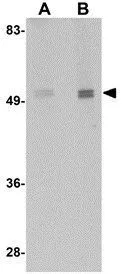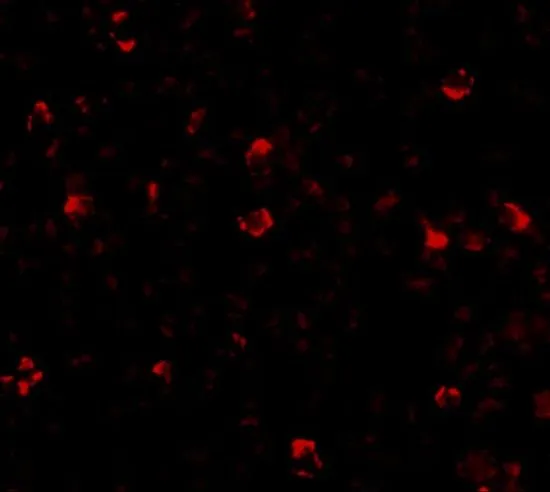
WB analysis of mouse brain tissue lysate using GTX85258 IRGC antibody. Working concentration : (A) 1 and (B) 2 microg/ml
IRGC antibody
GTX85258
ApplicationsImmunoFluorescence, Western Blot, ELISA, ImmunoCytoChemistry
Product group Antibodies
ReactivityHuman, Mouse, Rat
TargetIRGC
Overview
- SupplierGeneTex
- Product NameIRGC antibody
- Delivery Days Customer9
- Antibody SpecificityTwo isoforms of IRGC are known to exist; this antibody will recognize both isoforms.
- Application Supplier NoteWB: 1 - 2 microg/mL. ICC/IF: 2.5 microg/mL. *Optimal dilutions/concentrations should be determined by the researcher.Not tested in other applications.
- ApplicationsImmunoFluorescence, Western Blot, ELISA, ImmunoCytoChemistry
- CertificationResearch Use Only
- ClonalityPolyclonal
- Concentration1 mg/ml
- ConjugateUnconjugated
- Gene ID56269
- Target nameIRGC
- Target descriptionimmunity related GTPase cinema
- Target synonymsCINEMA; IFGGE; Iigp5; immunity-related GTPase cinema 1; immunity-related GTPase family, cinema 1; interferon-gamma-inducible GTPase IFGGE protein; interferon-inducible GTPase 5; IRGC1; R30953_1
- HostRabbit
- IsotypeIgG
- Protein IDQ6NXR0
- Protein NameInterferon-inducible GTPase 5
- Scientific DescriptionImmunity-related GTPases (IRG) (also known as p47 GTPases) are a family of GTPase proteins found in vertebrates, which play critical roles in mediating innate resistance to intracellular pathogens. IRG genes have been found in a number of mammals and lower species including mice, rats, zebrafish and humans. Most of the mouse genes contain interferon-stimulated response elements which mediate transcriptional activation by IFNs. In humans, only two IRG genes have been found: human IRGC encodes a full-length IRG protein that, like the mouse homologue, is constitutively expressed in testis, while human IRGM encodes a considerably truncated protein that is constitutively expressed in cultured cells including some macrophage cell lines. As the two human genes IRGC and IRGM are not subject to IFN control, it has been suggested that the host resistance mechanism supported by IRG proteins in the mouse is lacking in humans. Two isoforms of IRGC are known to exist; this antibody will recognize both isoforms.
- ReactivityHuman, Mouse, Rat
- Storage Instruction-20°C or -80°C,2°C to 8°C
- UNSPSC12352203


